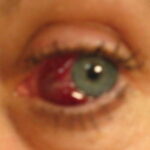Hemorrhage or bleeding, is the escape of blood from an injured blood vessel and may be visible on the skin (external) or may occur inside the body (internal). In severe bleeding the, the blood loss may lead to shock (because of inadequate blood circulating throughout the body), eventual coma and death if inadequate blood does not reach the brain.
Treatment of bleeding should be to stop it as soon as possible. All persons who are bleeding to any extent or are through to be bleeding internally should lie flat on their backs to make sure the maximum amount of what blood remains gets to the brain.
The extent of external bleeding depends on the size of the injured blood vessels involved. Superficial cuts in the skin involved. Superficial cuts in the skin involve only capillaries and slow red ooze is visible. If a vein is cut the flow is slow and dark red in color. Arterial bleeding is profuse, bright red and usually occurs in spurts. Firm pressure on the site of the bleeding should be applied forthwith, using a pad, for example a clean folded handkerchief.
If a leg is affected it should be raised and supported (for example on a stool or, if outdoors, on a log or fence) when the person lies down. An arm should b held up above the head. If the bleeding is profuse the pad should be held on until a secure padded bandage is available.
A person with a nosebleed should sit upright in a chair with the head not tilted back. He should be instructed to close the nostrils with the thumb and forefinger while an ice or cold pack is sought by another person and put over the bridge of the nose. The nose should be held for 10 minutes exactly, after which there should be no nose blowing nose poking to see if the nose is still bleeding. Should the bleeding continue the treatment should be repeated once. If it continues thereafter a doctor should be called.
A bleeding tongue or lip should be held firmly between the forefingers and thumb with a handkerchief or gauze swab on top of the bleeding point.
Internal hemorrhage
When significant internal bleeding occurs in a limb, a lump or swelling appears with in the next half hour. This is so of all fractures and severe sprains. Such swelling and bleeding should be reduced by raising the limb and applying an ice pack as long as is bearable or alternatively putting a firm crepe bandage over the whole of the injured area.
When the abdomen or chest wall has received a severe blow there may be internal bleeding into the lung or abdominal cavity because the lungs, spleen, liver or large abdominal vessels have been ruptured.
Diagnosis and emergency procedure
The simple key to whether there is bleeding or not shows in the pulse rate which becomes progressively faster and weaker until it finally becomes difficult to count or feel at all collapse ensues.
It is advisable to count the pulse for one minute and write down the rate and time either on a piece of paper or even on the patient’s forehead with lipstick. Note the pulse rate every 15 minutes thereafter. It is most important that the patient lies flat at all time.
Severe internal bleeding in the abdomen is a surgical emergency requiring rapid transit to hospital, resuscitation with blood transfusion and surgery to remove or stitch the bleeding organ or vessel. It is a help to the ambulance men, paramedics or doctor in the casualty department if a clear list of pulse rates in the intervening period has been made.
Source:
First Aid Review – Wounds and Bleeding Treatment, www.cpr-pro.com
Bleeding – Treatment, University of Maryland Medical Center, Jacob L. Heller, M.D., M.H.A., F.A.C.E.P, April 2008
Intracerebral Hemorrhage: Stroke (CVA), Merck Manual Professional, Elias A. Giraldo, MD, Jan 2007




